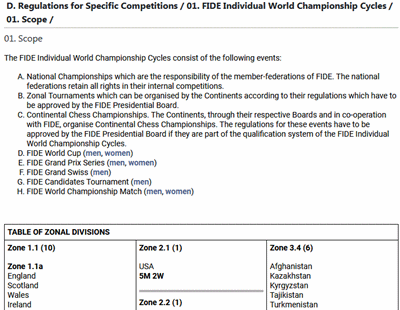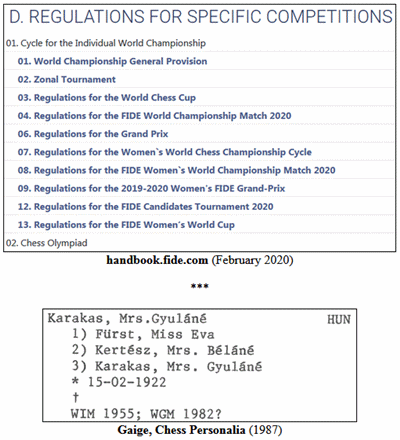The Association of Chess Professionals (ACP) recently issued a
Proposal For The World Championship Cycle
(chessprofessionals.org), where the essence of the proposal is:-
It seems natural then to make the open tournaments part of the World Championship cycle.
How did the group arrive at the conclusion that 'it seems natural'? The argument starts with a curious observation:-
Chess is often unfavourably compared to tennis. Unlike the tennis world, chess lacks an open, all-inclusive cycle that would encompass the top and the bottom of the pyramid. [...] Needless to say, a bottom-to-top cycle is a product that sponsors love to be part of.
Instead I would have guessed that what sponsors love is tennis as a superb spectator sport. It has action that is simple to understand, coupled with a scoring system that provokes many critical moments throughout a hard fought match. I'm a terrible tennis player, but I love to watch a close match between top players because of the drama and suspense. Sponsors love tennis because the public loves it and because the public's many eyeballs are associating the match with their product.
Maybe a 'bottom-to-top cycle' is indeed a hook for sponsors. I would better trust that statement coming from a sports marketing organization rather than from an elite group of top-level chess players. I could give other examples of suggestions by chess professionals to make their game more marketable, but none of them have succeeded in the past. Remember FIDE Commerce? Chess Network (CNC)? Worldchess.com?
Let's assume for a moment that the ACP has identified a game changer for chess marketing. Here is the next piece of their argument:-
In chess we have a well-established upper part of the pyramid. The World Championship match is the cherry on top, the Candidates Tournament is the most-awaited tournament, the Grand Prix tournaments, the World Cup and the Continental Championships all form a coherent system of qualification.
Overlooking the bizarre image of a cherry on top of a pyramid, can we really talk about a 'coherent system of qualification'?
The top players at the Continental Championships qualify into the World Cup, which along with the winners of the Grand Prix and the Grand Swiss qualify into the Candidates. (Or does the Grand Swiss only qualify into the World Cup? I'm too lazy to look it up. If the system were coherent, I wouldn't have to.)
And what about the Zonals, which are on the same qualification level as the Continentals? There are presently four levels of qualification :
Zonals, Continentals;
World Cup, Grand Prix, Grand Swiss;
Candidates;
World Championship.
What's coherent about that? To return to the ACP proposal:-
The lowest entry point for qualification in the World Championship cycle are the Continental Championships and these are not easily accessible to the lower-rated professionals, among other things because they are very expensive tournaments to play in. What is obviously missing here is the bottom part of the pyramid.
Again there is no mention of the Zonals. The Europeans eliminated their Zonals in 2001 (for cycle no.20 in my system of counting -- we're up to cycle no.29 now) and have been complaining ever since that the three other continents (the Americas, Asia, and Africa) kept their Zonals. Under the new ACP proposal, would the Zonals continue or would they be replaced by the opens?
As for the Continentals being 'expensive', is that because of travel costs -or- is there another reason? If it's because of travel costs, how would a series of open tournaments be less expensive? That would partially depend on the next question: Would a player who finishes 1st in one open have a better or worse chance of qualifying than a player who finishes 10th in 10 opens? (Or 5th in five opens, etc.)
In the Zonals, the top finishers qualify into the World Cup after a single tournament. The proposal continues:-
We would like to propose a concept where many open tournaments are part of a World Open Circuit. For this purpose the already well-established ACP Tour system or a similar one may serve as a basis on which the Circuit can be built.
Without doing any research on existing tournaments that might be incorporated into this scheme, I imagine they are concentrated in Europe.
In a future scheme, would they be evenly distributed across the four continents? (I'm again wondering about travel costs.)
On top of that, will ACP membership continue to be a requirement for eventual qualification?
The ACP ends the proposal with its weakest arguments. The first is a non-sequitur:-
The pause in over-the-board activities that the pandemic has forced us to have is an excellent opportunity for FIDE to prepare and reform the World Championship cycle by including the open tournaments in it.
The second is based on a work of fiction:-
Thanks to the popularity brought about by Netflix’s "The Queen’s Gambit" series, where such a climb from bottom to top is at the very center of the story that is currently inspiring the whole world.
All of the major chess news sources have issued reports on the ACP proposal. All have received comments from chess fans around the world. I'll try to find the time to review the many comments to see if I've overlooked the most important points.
***
Not long after I posted this essay, it appeared on the list of 'Popular Posts (Last 12 months)' at the bottom of every page on this blog.
That in itself is unusual.
At the same time, an older post appeared on the popular list:
Dual Qualification Paths
(July 2007). I knew that the two posts were related, but when I wrote the newer post, I didn't have the time to locate the older post. By some small twist of fate, it was done for me!


